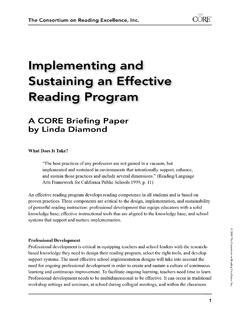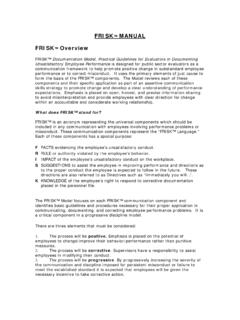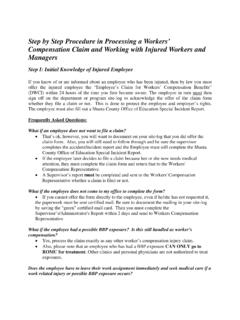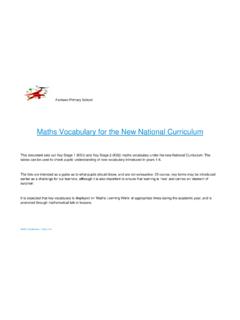Transcription of Active Engagement Strategies with Instruction Components
1 Active Engagement Strategies for Each Direct Instruction Component 1) Setting the Stage 6) Closure/ Assessment 2) Explaining To Students What to Do 3) Model for Students What to Do 4) Guided Practice 5) Independent Practice Active Engagement Strategies for Each Direct Instruction Component The six Components of Direct Instruction include: 1. Setting the Stage 2. Explaining to Students What to Do 3. Model for Students What to Do 4. Guided Practice 5. Independent Practice 6. Closure/Assessment In this packet are a variety of Active Engagement Strategies to use with each component. Many Strategies can be used with more than one component. The strategy will be described the first time it comes up in the component list, and referenced in the later Components .
2 Also in the packet will be references to the research materials and books from which the Strategies are taken. Check For Understanding Should be Done During Every Component, Along the Way! Title Page Book Description of Strategy Three Column Charts p. 105 Just ASK Publications, by ASK Inc. What I knew What I now know What I still don t know/wish I knew Signal Cards p. 109 Same as above Teacher can use whatever cards desired, but an easy place to start is with red, green, and yellow cards this way students can signal if they are lost, confused, fully understand, complete, run-on, or fragments, saturated, semi-surated, or unsaturated, etc. Manipulatives For sorting/categorizing p.
3 110 Same as above Index cards, strips of paper, or other objects can be moved and arranged to help teachers know who understands vocabulary terms, definitions, scientific terms, categorizing, etc. Mini White Boards, Slates, Think Pads, etc. p. 111 Same as above Teacher can see at a glance who understands or has the correct answer or not when at a teacher signal, every student holds up their mini white board, slate, or pad. Five card Draw p. 87 Same as above Students work in groups to review content. Prepare cards with vocabulary words, geographic locations, Components of mathematical equations, etc. As kids enter room, they take a card . They move about room to find four other students who fit their category.
4 The review begins at that point. Check For Understanding Should be Done During Every Component, Along the Way! Title Page Book Description of Strategy I have the Question, Who has the Answer? p. 85 Just ASK Publications, by ASK Inc. Each student has an answer card . A student turns over a question card from the center pile. The student reads the question and the student with the answer reads their card aloud. If the student was correct, then that person gets to turn over the next question card . Response Cards p. 46 Formative Assessment Techniques for Your Classroom by Douglas Fisher and Nancy Frey Response cards are index cards, signs, dry-erase boards, magnetic boards, or other items that are simultaneously held up by all students in class to indicate their response to a question or problem presented by the teacher.
5 Hand Signals p. 48 Same as above Similar to response cards, hand signals require Engagement from the whole group and allow the teacher to check for understanding in large groups of students. Active Engagement Strategies for Each Direct Instruction Component 1) Setting the Stage 5) Independent Practice Active Engagement Strategies for Setting the Stage Quick Scans p. 43-45 50 Strategies for Active Teaching A quick check around the room to gain insight into whether students have considerable background knowledge on the topic, some, or little many different options colored dots, fingers, a target , book look, etc. (see page 224 for template) Quick Writes 50 Students quickly write about a topic to activate relevant experiences or background knowledge on a topic Quick Draws p.
6 50-52 Same as above Students quickly draw in response to a prompt before studying a topic Idea Share p. 53-55 Same as above Students generate and share an idea related to a topic based on their experiences (see p. 225 for template) Partner Share p. 56 Same as above Students share what they know and anticipate new additions to what they know (see p. 226-227 for templates) Group Graphs p. 58-61 Same as above Students identify or gather information about a topic they will soon be studying and construct a graph representing the collective data from the class (see p. 228-229 for templates) Overheard Quotes p. 62-65 Same as above Students circulate to hear a variety of quotes related to the topic under study and then analyze and identify patterns in the quotes (see p.)
7 230 for template) True-False Sorts p. 66-68 Same as above Students work in small groups to sort statements into two stacks: statements that are true and those that are false Title Page Book Description of the Strategy Active Engagement Strategies for Setting the Stage Carousel p. 87-89 50 Strategies for Active Teaching Students respond with written brainstorming notes to topics or prompts on charts posted around the room Magnetic Quotes 50 Students read quotes/statements/ideas posted around the room, move to stand by one that interests them, and respond/discuss with peers Question Only Same as above Students ask questions about an upcoming topic of study (see pages 112-117 for details) Object-based Inquiry p.
8 124 Same as above Teacher presents objects and initial questions, then elicits questions that can be answered through empirical study Photo Analysis p. 134 Same as above Teacher obtains one or more photograph related to the topic/lesson and develops questions/prompts to lead students in analyzing the images Content Links p. 173 Same as above Students given a card with a word or short phrase, hold up their cards for peers to see as they circulate around the room and try to find someone with a card that fits with theirs Take a Stand p. 99 Instruction for All Students by Paula Rutherford (see page 99 for details) Purpose is to motivate students through controversy, give students a purpose for reading, and to use students experience base to involve them in new learning Exclusion Brainstorming p.
9 100 Same as above (see page 100 for details) Purpose is to predict and set a focus for learning, to find out what students think they know about a topic, and to build skills for analyzing possible connections Title Page Book Description of the Strategy Active Engagement Strategies for Setting the Stage All Hands on Deck p. 86 Just ASK Publications, ASK, Inc. Purpose is to promote participation by all students in a brainstorming session, focus students on topic, and to find out what kids know already Process use of chart paper, index cards, and small groups of students For details, variations, and description, see page 86 Stir the Class p.
10 98 Same as above Process have students write three reasons, three causes, three points of interest about the topic to be studied. They move from student to student sharing their ideas. Possible ideas, see page 98 Take a Stand Facts and Folklore Same as above Purpose is to discover what students know correctly and incorrectly about a topic and to differentiate between truth and fiction for concepts with much information in both forms Walking Tour Same as above Purpose is to introduce complex texts, ideas, or discrepancies, to emphasize key ideas of content, and to raise curiosity and speculation. Process use of charts and touring groups of students to go around the room touring the charts.









